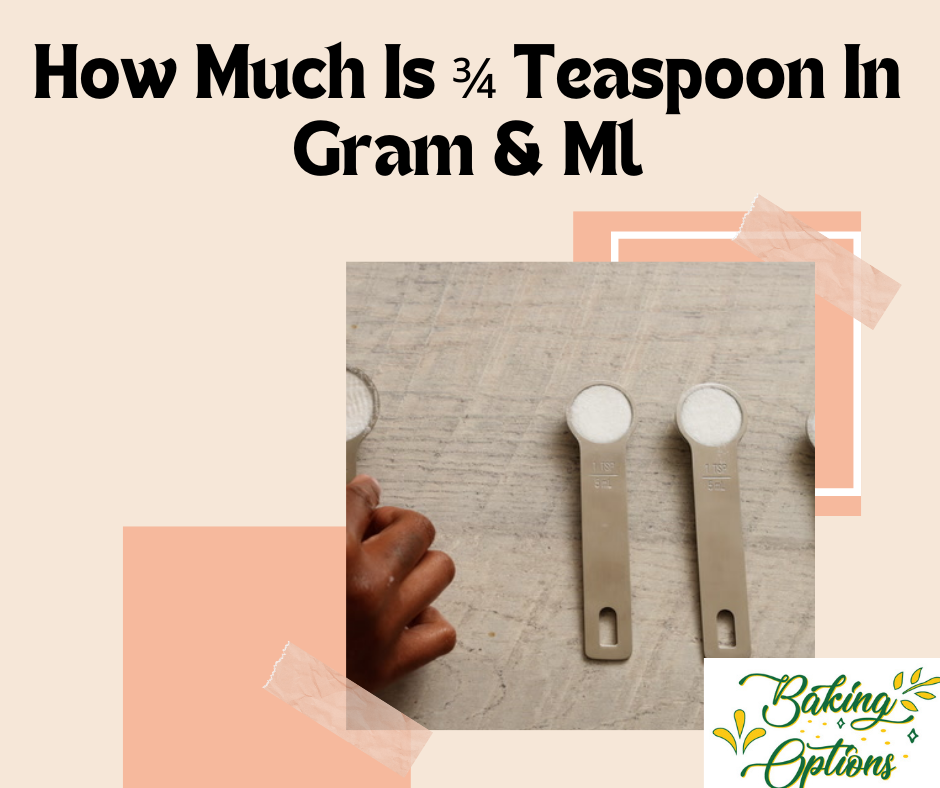When it comes to cooking and baking, exact measurement is essential. Some conversions are easy. But do you know how much is ¾ teaspoon in gram and Ml?
Some conversions are difficult to understand, so I will discuss the easy way to understand tricky conversions in this article.
Contents
Conversion Of ¾ Teaspoon into grams & Ml
¾ teaspoon To Ml
One teaspoon is equal to 5 ml. And the conversion of ¾ teaspoon would be like this:
¾ x 5 ml = 3.57 ml
¾ teaspoon To Grams
When measuring density similar to that of water, we use the following calculation for grams:
1 tsp = 5 ml g
¾ tsp = ¾ x 5 ml = 3.57 ml
Remember that precise measurements may vary depending on the density of the specific ingredient. Converting ingredients to grams will produce a different quantity than the milliliter measurement. For example, ¾ teaspoon in milliliters will not be the same quantity as in grams.
Also Read: How Many Teaspoons Are In a ¼ cup?
How To Measure ¾ Teaspoon Without a Measuring Spoon?

Here are some easy measurement tips that help you measure ¾ tsp without a measuring spoon:
- You can use the pinching method if you are working with dry ingredients. One pinch is found to be equal to ⅛ of a teaspoon, which was always accurate. Hence, when you use three pinches, you will obtain obtains ⅜ teaspoon. However, this conversion concerns only dry food materials, which is necessary.
- For the amount indicated for each type of dry herb for your recipe, you can use your kitchen scale to measure them in grams. For example, 3/4 of flour is about 90 grams, and 150 grams are used for sugar.
Take a bowl and make it balanced, or make it read a zero. Then, place the raw materials together until the scale weight is what you have indicated.
- Measuring cups might not be accessible, and if they are not, you can use another capacity container that can hold six fluid ounces, equivalent to three-fourths of a cup. This can be any container; use a small mason jar or food container for the best results.
If not, measure the liquid and transfer it to an 8-ounce container and then fill it with other substances to about three-fourths level.
Tips For Correct Measurements
Do not just estimate the portions; always use a standard measuring spoon. Make it a point to use a standard kitchen spoon in this process, which will help get the correct measurements.
Need to measure out flour or sugar for a recipe? The standard measuring tool makes precise volumetric measurements for solid ingredients. Using the measuring cup or spoon, pour the required ingredient to the brim, and then use a straight edge for the food to scrape off the excess to level.
This technique ensures you can measure the accurate amount needed in food preparation.
To eliminate systematic errors, it is recommended that measuring spoons and cups be greased with oil or used non-stick cooking spray before dipping them into the flour/other needed ingredients. Then scrape off excess material using a spatula.
With these measurements, you can get the accurate measurements for your recipe.
Helpful Conversion Tips for Cooking & Baking
Measuring is essential to achieve the expected outcome while preparing food, such as cooking or baking. Measuring flour, sugar, and similar products in grams rather than tablespoons is more accurate because their densities vary when packed.
Liquid ingredients are typically measured in milliliters (ml). Good measuring tools, such as a kitchen scale for weight measurement or a measuring cup for volume measurement, may also be used to maintain consistency.
In cooking, it’s helpful to have a conversion chart or an easy-to-use calculator for making conversions that are common in recipes.
¾ Teaspoon Conversion For Different Ingredients

Water Measurement
The weight and volume of ¾ teaspoon is the same for water, equal to 3.7 grams and 3.7 milliliters. It proves that the density of water is 1 gram per ml.
Salt Measurement
The density of salt is more than water, so the weight of ¾ teaspoon of salt is 4.5 grams. Due to the density of salt, the weight of salt is more than water.
Sugar measurement
The weight and volume of ¾ teaspoon equals 3.1 grams and 3.1 milliliters of sugar. The sugar density is less than salt, so the weight of cheese is less in the same volume.
Flour Measurements
The density of flour is less than that of sugar and salt, so the weight of ¾ teaspoon flour is only 2.5 grams. Due to the flour’s low density, the flour’s weight per teaspoon is less.
Also Read: What Is Half of 3/4th Cup?
FaQs
What is ¾ a teaspoon of in grams?
The weight in grams of ¾ teaspoon can differ depending on the recipe’s ingredient. For water, it is around 3.7 grams. For table salt, it takes approximately 4.5 grams. Caster sugar is about 3.1 grams, and the all-purpose flour is approximately 2.5 grams.
¾ teaspoon is equal to how many milliliters?
For water, ¾ teaspoon is equivalent to approximately 3.7 milliliters. This measurement generally applies to liquids with a density equal to water. Milliliters are less commonly used when measuring dry ingredients due to variations in thickness.
Why is the weight of ¾ teaspoon different for different ingredients?
The weight of ¾ teaspoon is different for different ingredients because the densities of the ingredients are different. Ingredients like salt and sugar are denser than flour and water. So, they weigh more per unit volume.
What is the best tool for small quantities in baking?
The digital kitchen scale is the most accurate tool for small quantities, especially baking. You can measure in grams or ounces for precision and use spoons for small volumes.
Conclusion
Measurements are crucial in cooking and baking, especially regarding recipes. Converting ¾ teaspoon to grams & milliliters can vary depending on the ingredient.
The measurement for ¾ teaspoon is approximately 3 grams or 3.7 milliliters. The items such as salt, sugar, and flour are measured in grams and have different weights.
Always, measurement spoons and kitchen scales should be used in a correct portioning of ingredients for cooking as well as baking such as cakes and other associated food items. These are the tips that you have to follow if you want to measure accurately.

